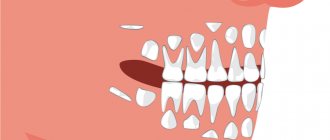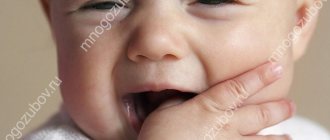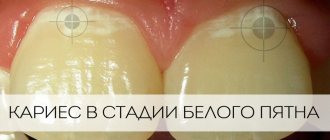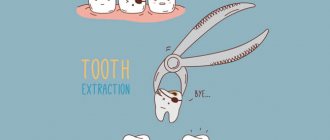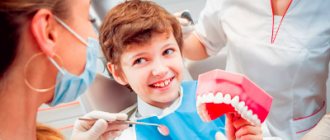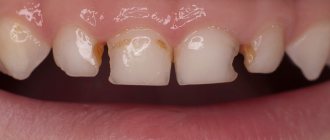Knowing the symptoms of teething and being able to provide assistance, loving parents will alleviate the baby’s condition and protect him from unpleasant complications. Often, teeth appear according to individual timing. Parents don't need to worry. A deviation from the norm of 1-2 months is not a pathology. If the schedule changes significantly, the help of a doctor is necessary. The examination begins with a pediatrician and dentist.
Signs that teeth are being cut
Many young parents do not immediately understand the reason for this child’s behavior and come up with terrible diagnoses before the doctor explains to them what the problem really is. But how not to confuse teething with illness or discomfort of the baby? At what age does the first tooth begin to cut? What to do to ease the baby's suffering? All this will be discussed below. Before the first teeth erupt, the baby feels discomfort, so he constantly tries to massage the gums with “improvised objects”
All babies experience the eruption of their first teeth differently: some go through this period steadily and relatively painlessly, while others suffer and suffer. It is difficult to explain what this difference depends on, but we can say with certainty that not a single newborn has had an absolutely comfortable teething process.
Anything can lead to such inflammation: serious pathologies or simple overwork. But most often, enlarged lymph nodes under the jaw signal problems with teeth or ENT organs. Read more in the article: “inflamed lymph node under the jaw - causes and treatment of the disease.”
How can parents determine that their baby has started teething? There are several symptoms that are most common.
- The baby's salivation increases, he begins to move his jaws more often, as if he is trying to chew something or massage his gums.
- The child becomes more excitable, he may cry more often for no reason, be capricious, sleep poorly, and sometimes refuse to eat.
- An increase in body temperature also indicates the appearance of the first teeth.
- The baby may have diarrhea.
- The gums become swollen and red, and itching appears. If such symptoms are present, the baby more often touches his mouth with his hands, tries to stick his fingers into it, and rubs his cheeks.
- Teething is often accompanied by a weakened immune system. Against this background, the baby may develop a cough or runny nose.
The formation of teeth in humans begins several months before birth. For example, baby teeth are formed in a baby in the fourth month of the mother’s pregnancy, and then (the fifth and sixth months) the molars are formed.
Tooth growth abnormalities in children
Unfortunately, the development and growth of teeth in children does not always occur as expected: there are a number of anomalies of various types that in one way or another affect the aesthetics and/or functionality of the teeth.
Causes of impaired growth and development of teeth:
- bad heredity;
- fetal injury during pregnancy or birth; intrauterine growth retardation, infections and so on;
- disruption of the endocrine system, thyroid dysfunction;
- lack of vitamins and minerals;
- mechanical, thermal and chemical injuries to teeth;
- bad habits in children that can affect the formation of teeth;
- lack of proper hygiene and poor diet.
Below is a table that describes the most common types of dental anomalies in children.
| Anomaly class | Description |
| Size of teeth | There are microdentia (too small teeth) and macrodentia (too large teeth). The anomaly can affect one or several teeth (and even the entire dentition). |
| Number of teeth | There is partial (lack of several teeth) and complete (absence of all teeth) adentia. Hyperdentia is a supernumerary set of teeth (usually in the second row). |
| Shape of teeth | Cone-shaped, barrel-shaped (Hutchinson's teeth), Pflueger's teeth (the neck is more developed than the coronal part). |
| Anomalies in the structure of enamel and dentin | Hypoplasia (spots and grooves on the body of the tooth), hyperplasia (tubercles, enamel drops, etc.), dentinogenesis imperfecta (violation of the structure and color of dentin). |
| Color irregularities | Enamel pigmentation (gray, black, amber enamel color). Most often it is caused by a disruption of the immune system during the prenatal stage of development. |
| Malocclusion | All types of dental malocclusions: mesial, cross, open, deep and so on. |
Despite the fact that some dental anomalies in children are quite serious, a timely visit to the dentist will help you avoid problems and maintain the health and beauty of your smile. If you let the situation take its course, unpleasant consequences will not keep you waiting.
Scheme of baby teeth eruption
To make it easier for parents to navigate the teething system, they can print out a reminder for themselves with a picture of the jaws, an indication of the teeth, and a description of exactly when certain dental units are cut.
The forehead is part of the T-zone, the area of the face that covers the forehead, nose and chin. The forehead is a problem area for many people because it is so close to your hair, which produces oil. Read more in the article: “why there are acne on the forehead.”
This is how a child’s teeth erupt according to the following pattern:
- 6-10 months - central incisor, lower jaw;
- 8-12 months - central incisor, upper jaw;
- 9-13 months - lateral incisors, upper jaw;
- 10-16 months - lateral incisors, lower jaw;
- 13-19 months - molar, upper jaw;
- 14-18 months - molar, lower jaw;
- 16-22 months - canines, upper jaw;
- 17-23 months - canines, lower jaw;
- 23-31 months - second molar, lower jaw;
- 21-31 months - second molar, upper jaw.
It turns out that at the age of two, the second molars of both jaws usually emerge. But it is difficult to say whether this is the most difficult teething for the baby. It is believed that fangs are more painful, which is due to their sharp edges. They literally tear the gums apart. The canines of the upper jaw are perhaps the most painful in their eruption. They are also called ophthalmic because they are connected to the facial nerve.
Table. Features of the eruption of baby teeth
| Category for evaluation | Description | Process Features |
| Age | Baby teeth erupt from six months to three years; if something doesn’t go according to plan, be sure to go to the doctor. | The average eruption rate may be shifted for some time |
| Duration | 2-7 days is the norm for the eruption of one tooth | It happens that this period is prolonged: if it lasts more than two weeks, consult a doctor |
| First tooth | Usually it takes longer to climb than others, i.e. more than a week | Depends on the individual characteristics of the body |
Many parents think that the first teeth are the most painful to cut, and the eruption of molars in two-year-old children is not accompanied by such pain. Therefore, parents may not understand what causes the capricious behavior of a two-year-old child, or what worries him.
How to brush your teeth correctly
- Your baby's teeth need to be brushed 2 times a day - in the morning and in the evening before bed.
- Use a small amount of toothpaste at first, about the size of a grain of rice, then work up to a pea-sized amount.
- If you use such a small amount of toothpaste, there is no need to rinse your mouth.
- Brush your teeth gently from the outside and inside.
- The tongue also needs to be cleaned, because bacteria accumulate on it, causing bad breath.
- Remember to change your toothbrush every 3 months.
At this stage, it is too early to floss because the teeth are usually far apart.
Eruption of second molars
The first fundamental units of the primary occlusion are the molars. They have the largest chewing area. They are diamond-shaped from above and cube-shaped from below. Children have 8 molars - two on each side below and above. The first molar and the second molar are distinguished. In terms of ranking from the central incisors, they occupy 4th and 5th positions. Their cutting order is as follows:
- the first in the lower jaw – 13-18 months;
- the first in the upper jaw – 14-19 months;
- the latter in the lower and upper jaws erupt approximately equally - at 23-31 months.
After a year, parents should prepare to meet these “guests”: the first to climb will be the one in the top row. By the age of two, the second ones appear. The correct sequence of appearance ensures a beautiful and correct bite. Many parents like to look into their babies' mouths and check how their teeth are coming in. You shouldn’t do this and worry the baby once again. Genetics plays a large role in this process.
There is no need to interfere: nature will take care of everything itself. A photo of molars will help you find out what chewing units look like. To help the child and alleviate his condition, it is very important for parents to know what the symptoms of teething are. Since the process occurs after a year, many children can already point to the sore spot and even say what they feel.
Permissible deviations
Don't be too alarmed if teeth erupt at intervals of several months or in the wrong order. But if the baby does not have incisors after 1 year, this is a reason to consult a specialist.
Usually, when the first tooth appears late, then all the others begin to cut late. If there is a hereditary factor, there is no need to worry.
Factors influencing deviations from the norm:
- weakened immune system;
- use of medications by the mother during pregnancy;
- sucking on a pacifier for a long time;
- lack of breastfeeding, bottle feeding;
- lack of vital elements in the diet;
- lack of necessary load on the jaws (mashed food).
Premature babies, babies with high body weight, and children on IV are at risk.
An acceptable deviation from the norm is a lag of six months. If a tooth begins to erupt with a discoloration, shape, or in the wrong direction, the baby should be shown to the dentist.
It is advisable to consult if teeth appeared too early or one of the paired incisors or molars is missing for a long time. Gaps in the dentition can be both normal and pathological.
In this video, the pediatrician talks about how many teeth should be at 2 years old and what to do if your child has deviations from the norm.
How to help your baby?
The only troubles that can be explained by the appearance of teeth are mild “crankiness”, drooling and the formation of bad habits, for example, finger sucking. Appetite may decrease, the rhythm of sleep and wakefulness may be disrupted due to constant itching of the gums. Of course, these manifestations do not bother the baby for 2 years without stopping; as a rule, there are days when the child shows the greatest concern about teething. How can you make life easier for a child during this difficult period?
- Remedy No. 1
. Double the affection and care of parents. Don't be afraid to spoil your baby; Constant crying and whims spoil your character much more! - Remedy No. 2
. Using teethers. These are rubber or plastic toys that your baby can bite on. Chewing teething rings with liquid inside, which can be placed in the refrigerator and cooled, is especially soothing. A child aged 6 months and older will feel better even after chewing on a clean, cold cloth. - Remedy No. 3
. Gently massage the gums with a gauze pad. Wrap your index finger in a gauze pad soaked in cold water and gently massage your baby's gums. - Remedy No. 4
. A homeopathic medicine that must be prescribed by a pediatrician or homeopathic physician. - Remedy No. 5
. Medicinal. Pain-relieving gels containing a local anesthetic, such as lidocaine (available in pharmacies without a prescription). They cause numbness in the gums and thereby relieve pain.
Many mothers believe that while the child has few teeth and they are baby teeth, it is not necessary to brush them. However, this is not true at all! In young children, the protective properties of tooth enamel are reduced and in the presence of provoking factors (consumption of sugar-containing products, poor oral hygiene), this can lead to the development of caries.
Taking care of dental health
By age 2, a child should have 16–20 teeth. But no matter how many there are, parents should be attentive to their health. Regular examinations of the baby’s oral cavity will help identify dental diseases at an early stage of development; if any violations are detected, you should contact the dentist. To prevent dental problems, moms and dads should:
- Properly organize the baby’s nutrition, try to prolong natural feeding: if the mother has breast milk, you need to feed the baby for at least six months . During regular visits to the pediatrician, parents receive recommendations from the doctor on the introduction of complementary foods (vegetable purees, juices, meat soups).
- Wean your child off pacifiers and bottles with nipples in a timely manner, as they damage teeth and can cause bottle caries.
- Give your baby not only soft foods and mashed purees, but also solid foods. At two years old, a child has enough teeth to chew vegetables and fruits. This helps strengthen the developing teeth.
Control the amount of sweets your child consumes.- Brush your baby's teeth with a soft-bristled brush without toothpaste or with a special children's toothpaste with a minimum content of harmful impurities. There are also devices for cleaning teeth that are made of soft silicone - they are put on the finger and clean the baby’s oral cavity.
- Periodically show the child to a pediatric dentist to monitor the condition of the teeth.
- Monitor the quality of water your baby drinks. The content of fluorine and other impurities in water should not exceed the norm.
If your child has a fever
A temperature of 37 degrees is considered normal; up to 37.5 this will also not be considered a special or complicated situation. Children usually feel fine with such a slight increase in temperature. Naturally, there is no point in giving an antipyretic in this case.
If the temperature rises above 38 degrees, it is worth saying that inflammation or infection has joined the teething process. This situation requires seeing a doctor (he needs to be called to your home), and only his recommendations will be your tactics in future behavior.
During this period, children experience pain, malaise, and weakness that were not typical before, so their behavior changes, sleep disturbances and refusal to eat are noted, which only aggravates the temperature reaction. First of all, the child needs rest, calm and healthy sleep, because temperature, on the one hand, is a protective reaction, and on the other, a debilitating process, which, if unfavorable, can cause overstrain of all organs and systems with the development of pathological reactions: weakness, drowsiness, tachycardia and even febrile seizures.
And remember that the antipyretic should be strictly for children, ideally recommended by a doctor. These are usually paracetamol-based drugs. If they do not help, you can give the child Ibuprofen (but it is prescribed to children from one year old).
But under no circumstances should children be given medications of the aspirin and analgin group. These are toxic drugs that cause side effects.
An excellent tactic for high temperatures would be to humidify the air in the room, regularly ventilate (while the child is in another room), drink plenty of fluids and eat as desired. The child should drink a lot of warm drinks and eat only when he wants to. Avoid dry air, wrapping yourself up in three pajamas and two blankets. If a child wants to play at a high temperature, there is no need to force him to go to bed.
It is important to understand that if the temperature is elevated for more than three days, it is unlikely that the problem is teething. And when it still doesn’t go astray, urgently call a doctor and look for the real reason for this reaction of the body.
Teething is not a very long period. By the age of three, it is definitely completed, and then you will already wait for the loss of milk teeth and the growth of permanent ones. As a rule, the child tolerates these processes normally. To make sure everything is in order, visit your pediatric dentist every six months. You can take care of baby teeth from the moment they appear. Teach your child to brush his teeth twice a day, monitor the quality of brushing.
What teeth appear first in children?
The rudiments of baby teeth and even some molars begin to form at the stage of intrauterine development, so modern diagnostic technologies make it possible to track this process and prevent some deviations. After birth, the first teeth usually begin to erupt when the baby reaches six months of age. This means he will soon be ready to eat more solid foods. In the vast majority of cases, the incisors appear first: as a rule, the lower central incisor becomes the “pioneer”.
Help from folk remedies
If you do not want to give your baby medications, you can use natural formulations. In this case, it is necessary to take into account the possibility of an allergic reaction in the baby. Also follow safety precautions and remember that small objects can be swallowed or choked by the baby.
- Amber beads
. These products are made from Baltic products. They have a pronounced analgesic and regenerating effect. In addition, the product can relieve fever and fever. The beads are made in such a way that they can enhance the effect of other medications. - Plant herbs
. Herbs such as chamomile and phytolacca can help alleviate the teething condition of a child. They relieve inflammation and partially relieve gum pain. Remember that they must be used in accordance with the instructions. You should not give your baby prepared formulas to drink. Simply treat the inflamed areas of the mucous membrane with the decoction.
